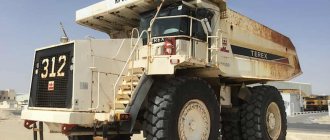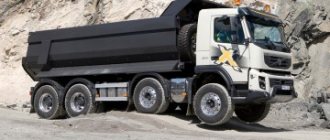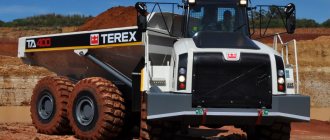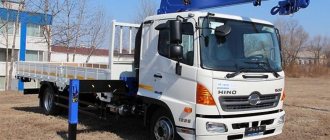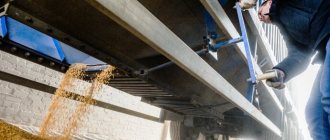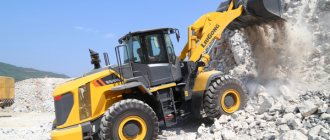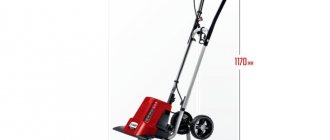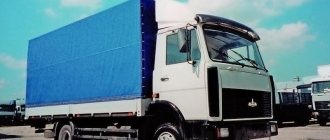The Chinese auto industry has been present on the Russian market for a long time, but it was the PRC dump trucks that forced it to be taken seriously. They have proven in practice that they are capable of working around the clock and in harsh climate conditions, even when Soviet-Russian special equipment could not stand it. The popularity of dump trucks in Russia is explained by the large shortage of such domestic equipment, while the Chinese auto industry offers a sufficient range at more favorable prices and delivery times.
Rating of new Chinese dump trucks
In recent years, new dump trucks from the Chinese automobile industry have proven themselves most successfully when operating in Russia, and are the most popular in the domestic market:
1. HOWO 4×2 ZZ3167M3811. Dump truck with a carrying capacity of 12-14 tons (body volume 7.7 m3), with a turbodiesel engine with a power of 290 hp. and intercooler. Has 6 speeds. mechanical transmission with differential lock. Maximum speed – 75 km/h.
2. HOWO (HOKA) ZZ3253N4641C1/NIFA 8×4. Dump truck with a lifting capacity of 31 tons, with a Steyr engine with a power of 336 hp. It has underbody heating with exhaust gases, a fluid coupling, ABS, and increased cabin comfort.
3. FAW 6×4 CA3253P7K2BT1A. A dump truck with a carrying capacity of 25 tons, an engine of 260 hp, a maximum speed of 80 km/h, and a fuel consumption of 26 l/100 km.
4. SHACMAN 6×4 SX3255DR384 F2000. New Chinese dump truck with a lifting capacity of 25 tons, 340 hp engine, 12-speed. Gearbox, high-speed axles, ABS, hydraulic outlets are installed for the dump trailer. The cabin is equipped with additional sound insulation.
5. FAW 3250 6x4 J6. Load capacity 19 tons (body volume 19 m3), turbodiesel 370 hp. with intermediate cooling.
6. Foton Auman BJ 3251, BJ 3253. Load capacity 13 tons, engine 336 hp, maximum speed 77 km/h, cabin equipped with a berth.
7. DongFeng DFL 3251 A. Load capacity 19 tons (body volume 15 m3), equipped with various engines (310, 340 and 375 hp) from Cummins.
Calculation of economic feasibility
Light Chinese dump trucks are rarely imported to Russia; most of the presented models have a load capacity of 20 tons and above. This is due to economic justification. In the segment of light dump trucks, it is more profitable to use Russian and Belarusian-made vehicles - MAZ, KamAZ, MAZ-MAN, as well as imported ones, but assembled in Russia, MAN and Ford Trucks.
Image source tespa.ru
However, in the heavy-duty dump truck segment, the choice becomes quite difficult. And here you will need to calculate the economic feasibility. For example, a 20-ton MAZ-5516 dump truck with a YaMZ engine consumes 30-60 liters of fuel per 100 km. Its closest competitor, the Shacman Shaanxi SX3255DR384, already consumes 25-50 liters of fuel per 100 km.
And if you need to transport cargo over a long distance, then the Chinese dump truck definitely wins. It costs several times less at a comparable price.
Major Chinese truck manufacturers
- Hovo. It is considered a leader in the production of dump trucks. On Russian roads, after passing a series of tests, it received high marks, including in frontal collisions. Fuel consumption on dump trucks is about 30 l/100 km, spare parts are manufactured at many well-known factories. The car cabin has good sound insulation, air conditioning, a comfortable seating area and an LCD display in place of the control devices.
- Shaanxi. A small plant is engaged in the production of dump trucks, which has become famous in Russia thanks to its products similar to the automaker MAN. All dump trucks are equipped with a Euro-2 engine, have good heat and sound insulation, are economical, with comfortable steering and body, with a capacity of 19 m3. The cars are equipped with electric torch fuel heating, a floating cabin suspension, a seating area and a comfortable driver's seat.
- Shacman. Cars from this manufacturer are produced using technology similar to Mercedes and have an optimal price-quality ratio. Equipped with a 6-cylinder 9.7 liter turbocharged engine and manual transmission. The driver's seat is equipped with air suspension and is adjustable to suit the driver's body characteristics. The maximum speed of dump trucks is up to 80 km/h, which is achieved quite quickly.
- Foton. A state-owned enterprise, it has been producing since 1996, leading the market for large machines. Dump trucks are supplied under the AUMAN brand, which are technologically identical to Shaanxi in most components and assemblies.
- JAC. The dump trucks of this automaker are distinguished by excellent comfort - an informative dashboard, anatomical seats, a berth, a tilt- and height-adjustable steering wheel, a viewing cabin and large rear-view mirrors. In addition, the car frame is reinforced with a specially designed channel.
- FAW. The automobile corporation began operations in 1953 and owns a large number of subsidiaries. FAW dump trucks are characterized by moderate fuel consumption, durability and low price. These are reliable and unpretentious machines that can cope with high loads. They are equipped with Bosch fuel systems, Wabco brakes, and power steering.
- Dongfeng. The company has been producing cars since 1969 and is closely associated with Cummins, whose engines it equips its trucks with. All modifications of dump trucks are produced on a 6x4 wheelbase with a 16m3 body, an engine pre-heater, an autonomous interior heater, climate control, a seating area, etc.
- Beifang Benchi. This brand produces vehicles jointly produced by DaimlerChrysler and FIRMAKO based on the licensed production of truck models that are not new and are no longer produced in Europe. The design of the dump trucks is simple, and the vehicles themselves have an optimal price-quality ratio. The power unit is 9.7 liters. turbocharged diesel, 280 hp The transmission is 9-speed manual, with center differential lock. The maximum speed of cars is limited to 80 km/h.
Right flank
The production programs of Chinese car factories include dozens of models in every imaginable configuration, including the most exotic. Naturally, for export purposes it is necessary to limit ourselves to a few, adapt them to the target market and unify the aggregate base as much as possible. This is the generally accepted world practice. Look how many models the Japanese produce for the domestic market and how many for the world market. Our official importers follow this direct, logical path.
In two years, a primary market for Chinese dump trucks was formed, followed, oddly enough, by a secondary market and sales leaders were identified. The most in demand are dump trucks with a wheel arrangement of 6x4, 8x4 and 6x6 with a load capacity from 20 tons to infinity.
Based on the sales results of imported trucks in 2007, Howo dump trucks (Sinotruk, Hania) took third place after Volvo and MAN. The result is impressive. We supplied 6523 new and 40 used ones. CNHTC China National Heavy Duty Truck Group Co., Ltd. produces engines under license from Steyr and several families of trucks - Steyr, Steyr King, Howo (Sinotruk) and Hania. The line of Euro 3 power units includes three models of in-line 6-cylinder engines - WD615.93 (290 hp derated), WD615.95 (336 hp base) and WD615.96 (375 hp boosted). The base engine is considered the most stable and reliable in operation, and it is this engine that is installed on the five-axle Howo with a gross weight of 53 tons.
Trucks under the Howo, Sinotruk and Hania brands - with the same filling, but with different cabins, rooted in Volvo, MAN, Scania. There are no complaints about the organization of the interior space of the cabins; they are distinguished from their European “ancestors” by less careful assembly and cheap materials. But the cabins stand out among their “compatriots” with a four-point floating suspension and a low seating position for the driver, i.e. these cabins are the most comfortable for the driver. Under the cabin there is a Steyr engine, coupled with a 9-speed unsynchronized Shaanxi gearbox. Dump trucks with a wheel arrangement of 6x4, 8x4 and 10x6 are supplied to Russia.
DongFeng took second place in the national standings at the end of 2005. 2,131 new and 578 used trucks were delivered of this brand. General dealer of DongFeng Motor Co. Chelyabinsk offers dump trucks with a wheel arrangement of 6x4, 6x6 and 8x4 with a gross weight of 33 and 39 tons. The DongFeng group of companies includes 42 factories that produce all components, including filters, including licensed Cummins and Renault engines. What sets DongFeng trucks apart from the mass of competitors is the harmonious design of the cabin, which, in general, is unusual for the Chinese school. And the interior decoration is at a good level.
Third place went to the products of Shaanxi Automobile Group Co. (76 new and 1695 used), made using MAN technology. In fact, in Shaanxi, only the F2000 cab remains from MAN technology. Under the cab there is a Steyr or Cummins engine, Guilin Fulda clutch and Shaanxi gearbox, ZF steering (licensed). Among its competitors, the cabin stands out better due to its internal volume and low engine tunnel. The choice of dump trucks is traditional - wheel arrangement 6x4 and 8x4, load capacity 21 and 24 tons.
Beiqi Foton Motor Co. closes the group of leaders, delivering 1,079 new and 5 used trucks in 2007. Trucks of the Foton Auman series with a wheel arrangement of 6x4 and 8x4 with a carrying capacity of 22 and 28 tons are equipped with Weichai-Steyr engines with licensed Bosch fuel equipment, Eaton Fuller gearbox, ZF steering, i.e. a standard Chinese set. The cabin design was updated a little over a year ago and attracts attention with a Europeanized style, subtly reminiscent of Scania design.
In addition to the official leaders, there are heavy equipment on the market from many other car factories - FAW, JAC, CAMC, Beifang Benchi, Youngman, Ling Ye (Naveco), Tie Ma, Hongyan, etc. At the same time, the internal content of this entire host is quite monotonous.
The main breakdowns and disadvantages of Chinese trucks
Owners of dump trucks from Chinese manufacturers may encounter the following typical problems:
- Load capacity. Carriers often overload vehicles, and they are not afraid of fines and breakdowns, since these amounts are already included in the cost of transportation. For this purpose, the sides of domestic trucks have always been extended. The situation became significantly worse with the advent of dump trucks from China. The problem is that the rated load capacity is exceeded due to the placement of a disproportionately large platform on the vehicle.
For example, a Chinese three-axle truck with a platform volume of 18 m3 can transport 29 tons of sand, but its permitted load capacity is only 22 tons. Or a four-axle dump truck with a body of 25 m3 and a load capacity of 25 tons can accommodate 40 tons, resulting in an overload of 15 tons.
- Unreliability of individual components and parts. Some car models have a disproportionately weak engine, or the unit itself contains low-quality parts, for example, friction linings that crumble during operation. On the first batches of Hovo, after several tens of thousands of km. The brake drum could fail, and the system itself could leak.
Shanxi's starter broke down after 10 thousand and the body lifting mechanism stopped working. If the truck had Chinese tires, they quickly failed and swelled from overload.
- Short service life. Cars break down quite often, and although this factor depends on timely maintenance, working conditions and the professionalism of the driver, in comparison with new European trucks, breakdowns occur more often. This is especially noticeable after two years of operation.
- Low speed indicators. The operation of Chinese trucks leads to their rapid wear. They are not designed for high speeds; moreover, under such operating conditions, the car begins to overuse fuel (up to 40%).
- Poor quality spare parts. Spare parts purchased in stores last much less than original ones. This applies to bearings, rods, bushings, fasteners, and other consumables. Some carriers find analogues to Chinese spare parts from European manufacturers.
- Weak electrics. The electrical systems in some trucks are not designed to withstand harsh climates, and they use iron wiring (instead of copper), which rusts and fails.
- Low residual value. A used truck cannot be sold for a high price, except to an inexperienced buyer.
Advantages of Chinese dump trucks
Today, most of the dump trucks in Russia are imported from China, while the range of companies and models is constantly expanding, adding to the well-known brands those that few have heard of. This equipment is positioned as the cheapest, combining reliability and modern technological innovations.
Certain disadvantages of dump trucks are associated with incomplete compliance with modern technological requirements, since many machine components are borrowed from previously created European vehicles. But this is compensated by the relatively low price, which is 10-20% lower compared to domestic analogues.
Chinese automakers have been successful in fixing identified common truck faults and are rapidly expanding their service network. This makes it possible to safely purchase Chinese dump trucks, without fear for their performance, and receiving qualified technical support.
“Ancestral” signs of a Chinese dump truck
The phenomenon arose when a Chinese dump truck met a Russian construction business at the right time, in the right place, and the meeting resulted in reciprocity. What is so valuable about a Chinese dump truck that builders love it so much?
First of all is the price. The price is competitive in comparison with Russian, Belarusian and used European dump trucks. It consists of powerful state protection of exporters, low-cost development, cheap steel and materials, high assembly rates, economies of scale, weak or complete lack of production control, strict and effective personnel policies, low wages compared to developed countries, and savings on more a number of costs, for example, environmental protection measures.
The unreliability of Chinese technology has become the talk of the town. Yes, there are sins, and while correcting one sin, Chinese designers fall into another. To summarize, these are design flaws, low quality, and unclear documentation for the cars.
With all its shortcomings, the Chinese dump truck is an attractive alternative to products from the domestic auto industry. It is no more unreliable than KamAZ, and at the same time it has a greater carrying capacity and power, i.e., at the same operating costs, the “Chinese” is more efficient, although for such overloads as Russian businessmen practice, the engines are rather weak. Failures are associated more with overload than with design flaws. Drivers who switched from KamAZ to a “Chinese” unanimously note that their working conditions have improved. During the construction boom, delivery times also played a role, when Chinese products turned out to be much more affordable than those from KAMAZ and MAZ.
Design flaws are generated by sprint development and national traditions. The development of a new model takes 2...4 months, which is not surprising. The new truck is assembled, like a designer, from a rather limited set of units - these are CNHTC engines (under license from Steyr), DongFeng (under license from Cummins), FAW (under license from Caterpillar) and Yuchai (not supplied to Russia), Shaanxi Fast Gear non-synchronized gearboxes Go (licensed by Eaton Fuller), DongFeng axles, Shaanxi Hande Axle (licensed by Steyr), Guilin Fuda clutch, ZF steering (licensed), Hyva body tipping cylinders (Hyva moved production from Europe to China). With all the diversity of automobile brands, the aggregate base is common - a consequence of gigantic circulations. National traditions are difficult to overcome. The domestic Chinese market is undemanding, devoid of the bourgeois craving for luxury and aesthetics: it goes, and that’s fine. Hence the carelessness in design.
The design of the cabin is based on the ancestors - Mitsubishi, Isuzu, Volvo, MAN, Mercedes-Benz and they are creatively modified taking into account the national flavor. It is worth noting that over the past two years, designers have made great progress in shaping both the external appearance of the cabin and its contents - the influence of the external market is felt. Export versions began to look very nice. The progenitor is mentioned in the phrase “created using the technology of Mitsubishi, Nissan, Isuzu, Volvo, etc.”, which is nothing more than an advertising slogan, meaning that the car plant once began with a license from a famous company. Modern dump trucks have nothing in common with old licenses that have lost all meaning.
Chinese factories are the most advanced, equipped with the latest technology and the best Japanese and European equipment, but they produce far from the best quality products. These are the conditions of the lowly domestic market. Export batches are assembled on the same conveyor belt, with the same hands, at the same speed and with the same shortcomings.
The design is finalized and shortcomings are eliminated when the model has already gone into production. Cars of the same model, but different months of production, may differ in configuration and in the design of individual components or systems. Changes are made both to improve and to reduce the cost of production. Even within the same batch, dump trucks may vary. This misgrading aggravates the already difficult situation with spare parts. This is especially true for cars intended for the domestic Chinese market and imported into Russia through “gray” routes. It is almost impossible to obtain spare parts for such a machine. In this context, we can recall another paradox of the Chinese auto business - the generals of their auto industry declare a fight against “gray” dealerships and at the same time are ready to sell anything to anyone.
To the credit of a number of dealers, among which is Chelyabinsk, they, firstly, select models that best meet the requirements of the Russian market, work with factories to bring the design to fruition, certify cars and try to develop service. Fortunately, the factories are meeting their wishes. Chinese businessmen have the ability to quickly adapt to changing conditions. If the dealer makes reasonable demands, then they must be satisfied, and quickly. Thus, at the request of Intekra, DongFeng Motor made more than 260 changes to the design of the DongFeng dump truck - instead of 300-horsepower, 375-hp engines were installed, fully synchronized gearboxes, interwheel and center differential locks, a 400-liter fuel tank, etc. Ruspromavto also demanded that SAMC (Chinese Automobile Maanshan Company) adapt it to Russian conditions - reworking the brake system, lighting, replacing tires, moving the battery box and fuel tank, adding a body heating system with exhaust gases.
Incomprehensible documentation for a Chinese car has a greater impact than it seems at first glance, since it introduces an error at the very beginning - when choosing a dump truck, and all problems become a consequence of this error. Thus, a dump truck designed for transporting light materials, with a huge body and weak frame, suspension and axles, is bought to transport granite crushed stone. And only because the documentation does not indicate the purpose of the car and the characteristics, including curb and gross weight, are incorrectly indicated.
On a short shoulder, the “Chinese” justifies itself. The costs of its evacuation and other risks in this case are minimal, the price and operating costs are comparable to those for KamAZ, while the “Chinese” hauls more and faster.
Features of Chinese dump trucks
Dump trucks from China successfully make up for the shortage of similar vehicles from the domestic auto industry, while having an advantage over it in the following points:
- Cars are quickly delivered and repaired.
- The main parts are produced at the factories of well-known manufacturers.
- Successful experience of operation all year round in any conditions.
- Good quality at a price lower than competitors.
- No shortage of spare parts.
Like any other cargo equipment, Chinese dump trucks have the following modifications:
- By type of unloading – inclined and forced.
- By body type - bunker, sliding or stable platform.
- In the direction of unloading - universal or in any one direction.
- Lift type: hydraulic, telescopic.
- According to potential load and dimensions from 4x2 to 10x6.
